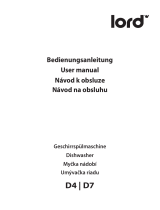Page is loading ...

1
EN
English
Operating instructions
DISHWASHER - Contents
Operating instructions, 1
Important Safety Instructions, 4-5
Assistance, 5
Product Data, 6
Installation, 18-19
Description of the appliance, 20
Refined salt and rinse aid, 21
Loading the racks, 22-23
Detergent and dishwasher use, 24
Wash cycles, 25
Special wash cycles and options, 26
Care and maintenance, 27
Troubleshooting, 28
GCF 625
DE
Deutsch
Gebrauchsanleitung
GESCHIRRSPÜLER – Inhaltsverzeichnis
Gebrauchsanleitung, 1
Wichtige
Sicherheitsinformationen
, 2-3-4
Kundendienst, 5
Produktdatenblatt, 6
Installation, 7-8
Beschreibung Ihres Geschirrspülers
, 9
Regeneriersalz und Klarspüler
, 10
Beladen der Körbe, 11-12
Spülmittel und Verwendung des Geschirrspülers, 13
Programme, 14
Sonderprogramme und Optionen, 15
Reinigung
und Pflege, 16
Störungen und Abhilfe, 17

4
zur korrekten Entsorgung von
Haushaltsgeräten kontaktieren Sie die
zuständige Behörde oder den lokalen
Händler.
EN
IMPORTANT SAFETY
INSTRUCTIONS
Read the instructions carefully before
using, as they include important information
on safe installation, use and maintenance.
Keep this instruction manual in a safe place
for future reference. If the appliance is sold,
given away or moved, make sure the manual
is kept with the machine.
Remove the appliance from all packaging
and make sure it was not damaged during
transportation, if it was damaged contact the
retailer and do not proceed any further with
the installation process.
When using your dishwasher, follow
the precautions listed below:
• The appliance must be used to wash
domestic crockery in accordance with the
instructions in this manual.
• This appliance can be used by children
aged from 8 years and above and persons
with reduced physical, sensory or mental
capabilities or lack of experience and
knowledge if they have been given
supervision or instruction concerning
use of the appliance in a safe way and
understand the hazards involved. Children
shall not play with the appliance.
• Cleaning and user maintenance shall not
be made by children without supervision.
• The appliance must not be installed
outdoors, even in covered areas. It is
extremely dangerous to leave the machine
exposed to rain and storms.
• Do not store flammable materials in close
proximity to the appliance.
• The water in the appliance is not potable.
• Do not use solvents inside the appliance:
risk of explosion!
• The door should not be left in the open
position since this could present a tripping
hazard.
• Do not rest objects on the open door or sit
or stand on it since the appliance could trip
forward.
• The open appliance door can only support
the weight of the loaded rack when pulled
out.
• The water supply tap must be shut off
and the plug should be removed from the
electrical socket at the end of every cycle
and before cleaning the appliance for
carrying out any maintenance work also
disconnect in the event of any malfunction.
• Repairs and technical modifications must
be carried out exclusively by a qualified
technician.
• When unplugging the appliance always
pull the plug from the mains socket. Do not
pull on the cable.
• In order to avoid laceration hazard,
usage of special gloves is needed during
the assembling of the appliance.
• During use, the access to the rear wall
should be limited in a sustainable manner
such as approaching the device to the wall
or furniture board.
• Keep packaging materials out of the reach
of Children, packaging materials should
not be used as a toy.
• Children must not be allowed to play with
the appliance.
• Store the detergent, rinse aid and salt out
of the reach of children.
• Appliance is dedicated only for household
use.
• Appliance can not be operated until
installation process is complete.
GROUNDING INSTRUCTIONS
• This appliance must be grounded. In the
event of a malfunction or breakdown,
grounding will reduce the risk of an
electric shock by providing a path of
least resistance of electric current. This
appliance is equipped with a cord having
an equipment- grounding conductor and
a grounding plug.
• The plug must be plugged into an
appropriate outlet that is installed and
grounded in accordance with all local
codes and ordinances.
• Extension cord, adapters and conversion
plugs must not be used to connect the
appliance to the outlet.
• Improper connection of the equipment-
grounding conductor can result in the risk
of an electric shock.
• Check with a qualified electrician or service
representative if you are in doubt whether
the appliance is properly grounded. Do
not modify the plug provided with the
appliance; If it does not fit the outlet. Have
a proper outlet installed by a qualified
electrician.

5
PROPER USE
• Access to disconnection of the appliance
(main plug) shall be ensured after
installation.
• When loading items to be washed:
1 - Locate sharp items so that they are not
likely to damage the door seal;
2 - WARNING: Knives and other utensils with
sharp points must be loaded in the cutlery
basket with their points/blades down or
placed in a horizontal position with the
sharp end facing away from the front of
the appliance.
• Use only detergent and rinse additives
designed for an automatic dishwasher.
• WARNING: Some dishwasher detergents
are strongly alkaline. They can be extremely
dangerous if swallowed. Avoid contact with
the skin and eyes and keep children away
from the dishwasher when the door is open.
Check that the detergent receptacle is
empty after completion of the wash cycle.
• If the supply cord is damaged, it must
be replaced by the manufacturer or its
service agent or a similarly qualified person
in order to avoid a hazard.
• During installation, the power supply must
not be excessively or dangerously bent or
flattened. Do not tamper with controls.
• To dispose of any packaging materials,
follow local legislation so that the
packagings may be reused.
• Use the dishwasher only for its intended
function.
• The appliance is to be connected to the
water mains using new hose sets. The old
hose-sets should not be reused.
• The maximum number of place settings is
shown in the product sheet.
SAFEGUARDING THE ENVIRONMENT
• This appliance has been made of recyclable
or re-usable material. Scrapping must be
carried out in compliance with local waste
disposal regulations. Before scrapping it,
make sure to cut off the mains cord so that
the appliance cannot be re-used.
• For more detailed information on handling
and recycling of this product, contact your
local authorities who deal with the separate
collection of rubbish or the shop where you
bought the appliance.
SCRAPPING OF PACKAGING
•The packaging can be 100% recycled
as confirmed by the recycling symbol .
The various parts of the packaging must
not be dispersed in the environment, but
must be scrapped in line with local authority
regulations.
• The European Directive 2012/19/EU
relating to Waste Electrical and Electronic
Equipment (WEEE) states that household
appliances should not be disposed of using
the normal solid urban waste cycle.
Exhausted appliances should be collected
separately in order to optimise the cost of
reusing and recycling the materials inside
the machine, while preventing potential
damage to the atmosphere and public
health. The crossed-out dustbin symbol
shown on all products reminds the owners
of their obligations regarding separated
waste collection. For further information
relating to the correct disposal of household
appliances, owners may contact the
relevant public authority or the local
appliance dealer.
DE
Kundendienst
Bevor Sie den Kundendienst anfordern:
• sollten einige Kontrollen vorab selbst durchgeführt werden
(siehe Störungen und Abhilfe)
.
• Starten Sie das Programm erneut, um sicherzustellen, dass
die Störung behoben wurde.
• Ist dies nicht der Fall, wenden Sie sich bitte an den autorisierten
Kundendienst.
Beauftragen Sie bitte niemals unbefugtes Personal.
Geben Sie bitte Folgendes an:
• die Art der Störung
• das Gerätemodell (Mod.)
• die Seriennummer (S/N).
Diese Informationen können Sie auf dem am Gerät befindlichen
Typenschild ablesen
(siehe Beschreibung Ihres Geschirrspülers).
EN
Assistance
Before contacting Assistance:
• Check whether the problem can be resolved using the
Troubleshooting guide
(see Troubleshooting).
• Restart the programme to check whether the problem has
ceased to exist.
• If the problem persists, contact the Authorised Technical
Assistance Service.
Never use the services of unauthorised technicians.
Please have the following information to hand:
• The type of malfunction.
• The appliance model (Mod.).
• The serial number (S/N).
This information can be found on the appliance data plate
(see
Description of the appliance)
.

6
Datenblatt
Marke
BAUKNECHT
Modell
GCF 625
Nennkapazität in Standardgedecken für den Standardreinigungszyklus (1)
10
Energieefzienzklasse (A+++ niedriger Verbrauch) bis D (hoher Verbrauch)
A+
Energieverbrauch pro Jahr in kWh (2)
237
Energieverbrauch Standardreinigungszyklus in kWh
0.83
Gewichtete Leistungsaufnahme im Aus-Zustand in W
0.5
Gewichtete Leistungsaufnahme im unausgeschalteten Zustand in W
5.0
Wasserverbrauch pro Jahr in Liter (3)
2800
Trocknungsefzienzklasse (A höchste Efzienz) bis G (geringste Efzienz)
A
Programmdauer des Standardreinigungszyklus in Minuten
180
Dauer des unausgeschalteten Zustands nach Programmende
12
Luftschallemissionen dB(A) re 1pW
49
Einbaugerät
Nein
1) Angabe auf Grundlage von 280 Standardreingungszyklen bei Kaltwasserbefüllung und dem Verbrauch der Betriebsarten mit geringer
Leistungsaufnahme. Der tatsächliche Energieverbrauch hängt von der Art der Nutzung des Geräts ab.
2) Die Angaben beziehen sich auf den Standardreinigungszyklus. Dieses Programm eignet sich zur Reingung von normal
verschmutztem Geschirr und ist am efzientesten in Bezug auf den kombinierten Energie- und Wasserverbrauch. Der
Standardreingungszyklus entspricht dem Eco Zyklus.
3) Angabe auf Grundlage von 280 Standardreingungszyklen. Der tatsächliche Energieverbrauch hängt von der Art der Nutzung des
Geräts ab.
DE
Datenblatt
Product Fiche
Brand
BAUKNECHT
Model
GCF 625
Rated capacity in standard place settings (1)
10
Energy efciency class on a scale from A+++ (low consumption) to D (high consumption)
A+
Energy consumption per year in kWh (2)
237
Energy consumption of the standard cleaning cycle in kWh
0.83
Power consumption of the off-mode in W
0.5
Power consumption of the left-on mode in W
5.0
Water consumption per year in litres (3)
2800
Drying efcacy class on a scale from G (low efcacy) to A (high efcacy)
A
Programme time for standard cleaning cycle in minutes
180
The duration of the left-on mode in minutes
12
Noise in dB(A) Re 1pW
49
Built-in model
No
NOTES
1) The information on the label and che relates to the standard cleaning cycle, this programme is suitable to clean normally soiled
tableware and it is the most efcient programme in terms of combined energy and water consumption. The standard cleaning cycle
corresponds to the Eco cycle.
2) Based on 280 standard cleaning cycles using cold water ll and the consumption of the low power modes. Actual energy consumption
depends on how the appliance is used.
3) Based on 280 standard cleaning cycles. Actual water consumption depends on how the appliance is used.
EN
Product Data (product fiche)

18
EN
If the appliance must be moved at any time, keep it in an
upright position; if absolutely necessary, it may be tilted onto
its back.
Connecting the water supply
Adaptation of the water supply for installation should only
be performed by a qualified technician.
The water inlet and outlet hoses may be positioned towards
the right or the left in order to achieve the best possible
installation.
Make sure the dishwasher does not bend or squash the hoses.
Connecting the water inlet hose
• Toa3/4”coldorhotwaterconnectionpoint(max.60°C).
• Runthewateruntilitisperfectlyclear.
• Screwtheinlethosetightlyintopositionandturnoffthe
tap.
If the inlet hose is not long enough, contact a specialist
store or an authorised technician
(seeAssistance)
.
The water pressure must be within the values indicated
in the Technical Data table - otherwise the dishwasher may
be function properly.
Make sure the hose is not bent or compressed.
Connecting the water outlet hose
Connect the outlet hose to a drain duct with a minimum
diameterof2cm.(A)
The outlet hose connection must be at a height ranging from
40to80cmfromthefloororsurfacewherethedishwasher
rests.
Before connecting the water outlet hose to the sink drain,
removetheplasticplug(B).
Anti-flooding protection
To ensure floods do not occur, the dishwasher:
- is provided with a special system which blocks the water
supply in the event of anomalies or leaks from inside
theappliance. Some models are also equipped with the
supplementary safety device New Acqua Stop, which
guarantees anti-flooding protection even in the event of a
supply hose rupture.
WARNING: HAZARDOUS VOLTAGE!
Under no circumstances should the water inlet hose be cut
as it contains live electrical parts.
Electrical connection
Before inserting the plug into the electrical socket, make
sure that:
• Thesocket is earthed and complies with current
regulations;
• thesocket can withstand the maximum load of the
appliance as shown on the data plate located on the inside
of the door
(seechapterDescriptionoftheappliance);
• Thepowersupplyvoltagefallswithinthevaluesindicated
on the data plate on the inside of the door.
• Thesocketiscompatiblewiththeplugoftheappliance.If
this is not the case, ask an authorised technician to replace
theplug(
see Assistance
).Donotuseextensioncablesor
multiple sockets.
The cable should not be bent or compressed.
If the power supply cable is damaged, have it replaced
by the manufacturer or its authorised Technical Assistance
Service in order to prevent all potential hazards.
(See
Assistance)
The Company shall not be held responsible for any
incidents, if these regulations are not observed.
Positioning and levelling
1. Position the dishwasher on a level sturdy floor. If the floor is
uneven, the front feet of the appliance may be adjusted until
itreachesahorizontalposition.Iftheapplianceislevelled
correctly, it will be more stable and much less likely to move
or cause vibrations and noise while it is operating.
2. Before recessing the dishwasher, stick the adhesive
transparent strip under the wooden shelf in order to protect
it from any condensation which may form.
3. Place the dishwasher so that its sides or back panel
are in contact with the adjacent cabinets or the wall. This
appliance can also be recessed under a single worktop
(see
theAssemblyinstructionsheet)
.
4.Toadjusttheheightoftherearfoot,turntheredhexagonal
bushing on the lower central part at the front of the dishwasher
usingahexagonalspannerwithanopeningof8mm.Turnthe
spanner in a clockwise direction to increase the height and
in an anticlockwise direction to decrease it.
(seeBuilding-in
instructionsheetattachedtothedocumentation)
Installation
MIN 40 cm
MAX 80 cm

19
EN
Advice regarding the first wash cycle
After the installation, remove the stoppers from the racks and
the retaining elastic elements from the upper rack
(ifany).
Water softener settings
Before starting the first wash cycle, set the hardness lev-
el of the water from the mains supply.
(seechapterRinse
aid and refined salt).
First load the softener tank with water, then introduce about
1 kg of salt. It is perfectly normal for water to flow out.
As soon as this procedure is complete, run a wash cycle.
Only use salt that has been specifically designed for dish-
washers.
After the salt has been poured into the machine, the LOW
SALTindicatorlightswitchesoff.
If the salt container is not filled, the water softener and the
heating element may be damaged as a result.
Technical data
Dimensions
width 45 cm
height 85 cm
depth 60 cm
Capacity 10 standard place-settings
Water supply pressure
0,05 ÷ 1MPa (0.5 ÷ 10 bar)
7,25 psi – 145 psi
Power supply voltage See appliance data plate
Total absorbed power See appliance data plate
Fuse See appliance data plate
This dishwasher conforms to the
following European Community
Directives:
-93/68/EEC (CE Marking)
-2006/95/EC (Low Voltage)
-2004/108/EC (Electromagnetic
Compatibility)
-2009/125/EC (Comm. Reg.
1016/2010) (Ecodesign)
-2010/30/EC (Energy Labelling)
-2011/65/EC (RoHS)
-2012/19/CE Waste Electrical
and Electronic Equipment (WEEE)
The machine has a buzzer/set of tones to inform the user that
a command has been implemented: power on, cycle end etc.
The symbols/indicator lights/LEDs on the control panel/
display may vary in colour and may have a flashing or fixed
light.
The display provides useful information concerning the type
of wash cycle, drying/wash-cycle phase, remaining time,
temperature etc.

20
EN
Overall view
Description of the
appliance
1. Upper rack
2. Upper spray arm
3. Tip-up compartments
4. Rackheightadjuster
5. Lower rack
6. Lower spray arm
7. Cutlery basket
8. Washing filter
9. Saltdispenser
10. Detergent and rinse aid dispensers
11. Data plate
12. Control Panel
Control panel
Select Wash Cycle button
and indicator light
Hygiene Rinse Option button
and indicator light/ Tab
Start Delay
Option button and
indicator light
ON/OFF/RESET
button and
indicator light
Half Load Option button and
indicator light/ child lock
Eco cycle
indicator light
Child lock
indicator light
Wash-Cycle number
and Remaining Time
indicator
Tablet indicator light
(Tab)
Salt indicator light
Rinse Aid indicator light
Closed water tap
indicator light
Display
Start/Pause button
and indicator light
/ Drain out
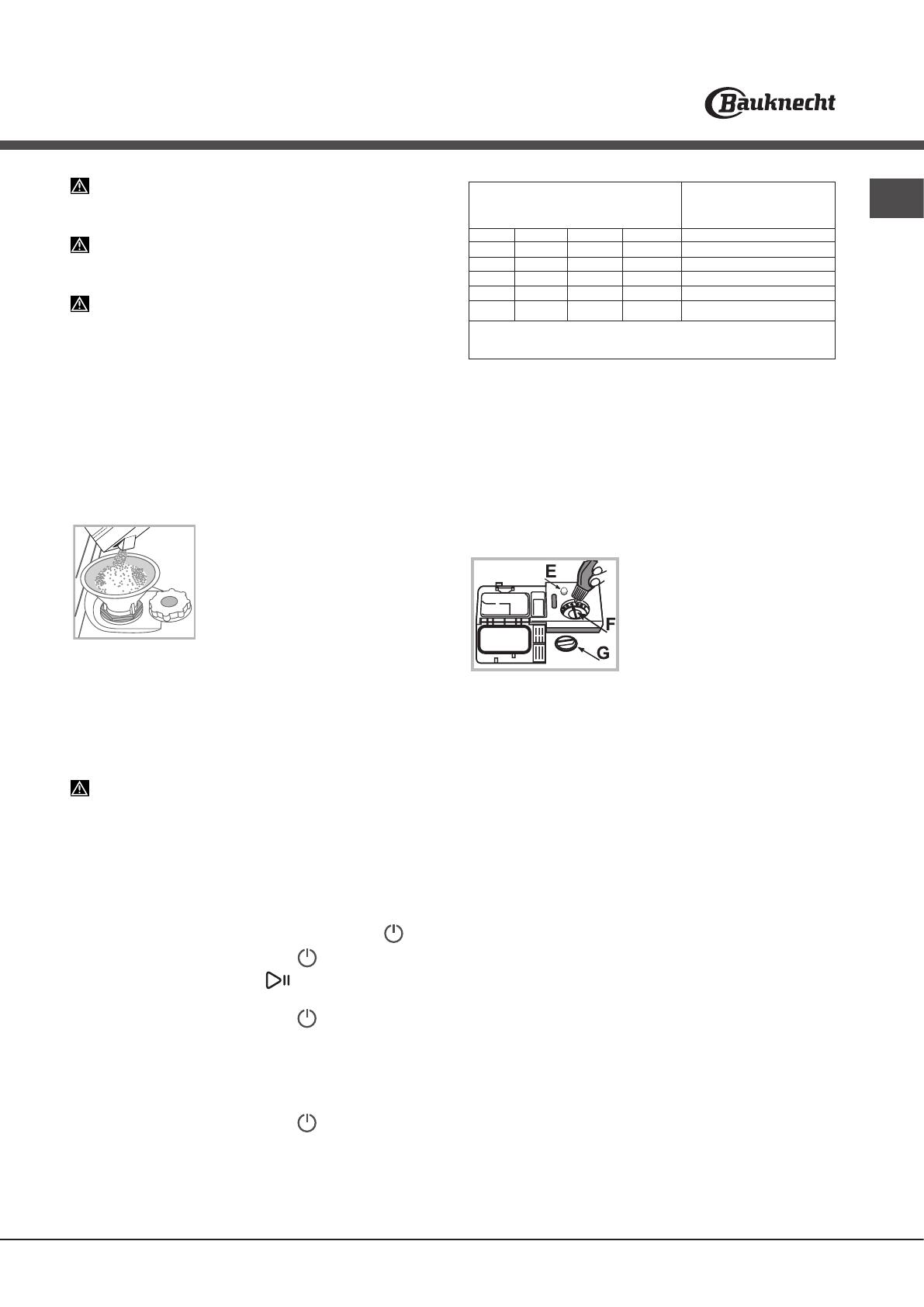
21
EN
(°dH=hardnessmeasuredinGermandegrees-°f=hardness
measuredinFrenchdegrees–mmol/l=millimolesperlitre)
Measuring out the rinse aid
RinseaidmakesdishDRYINGeasier.Therinseaiddispenser
should be filled:
• WhentheLOWRINSEAIDindicatorlightonthepanel/display
is lit;
• Whenthedarkopticalindicatoronthedispenserdoor“E”
becomes transparent.
1. Open the dispenser by turning
the cap "G" in an anticlockwise
direction.
2. Pour in the rinse aid, making
sure it does not overflow from the
dispenser. If this happens, clean
the spill immediately with a dry cloth.
3.Screwthecapbackon.
NEVER pour the rinse aid directly into the tub.
Adjusting the amount of rinse aid
If you are not completely satisfied with the drying results, you
can adjust the quantity of rinse aid used. Turn the adjuster “F”.
Amaximumof4levelscanbesetaccordingtothedishwasher
model. The factory setting is for a medium level.
• Ifyouseebluishstreaksonthedishes,setalownumber(1-2).
• Iftherearedropsofwaterorlimescalemarksonthedishes,
setahighnumber(3-4).
Only use products which have been specifically designed
for dishwashers. Do not use table salt or industrial salt.
(Followtheinstructionsgivenonthepackaging.)
If you are using a multi-function product, we recommend
that you add salt in any case, especially if the water is hard
or very hard.
(Followtheinstructionsgivenonthepackaging.)
If you do not add salt or rinse aid, the LOW SALT and
LOW RINSE AID indicator lights will remain lit.
Measuring out the refined salt
The use of salt prevents the formation of LIMESCALE on the
dishes and on the machine's functional components.
•Itisimportantthatthesaltdispenserbeneverempty.
•Itisimportanttosetthewaterhardness.
The salt dispenser is located in the lower part of the dishwasher
(seeDescription)
and should be filled:
• WhentheLOWSALTindicatorlightinthecontrolpanelislit;
• Seeautonomyinthewaterhardnesstable.
1. Remove the lower rackand unscrewthe containercap
(anticlockwise).
2. Only the first time you do this: fill the
water dispenser up to the edge.
3. Position the funnel
(see figure)
and
fill the salt container right up to its edge
(approximately1kg);itisnotunusualfor
a little water to leak out.
4.Removethefunnelandwipeanysalt
residue away from the opening; rinse the cap under running
water and then screw it on.
It is advisable to perform this procedure every time you add salt
to the container.
Make sure the cap is screwed on tightly, so that no detergent can
getintothecontainerduringthewashcycle(thiscoulddamage
the water softener beyond repair).
Whenever you need to add salt, we recommend carrying out
the procedure before the washing cycle is started.
Setting the water hardness
For perfect water softener operation, it is essential that the
adjustment be based on the water hardness in your house. Ask
your local water supplier for this information. The factory setting
is for medium water hardness.
•SwitchthedishwasheronusingtheOn/Offbutton.
•SwitchitoffusingtheOn/Offbutton
•HolddowntheSTART/PAUSE button for 5 seconds until
you hear a beep.
•SwitchitonusingtheOn/Offbutton
•Thedisplayshowsthecurrentselectionlevelnumberandthe
salt indicator light.
• Press button P to select the desired hardness level
(see
HardnessTable).
•SwitchitoffusingtheOn/Offbutton
•Settingiscomplete!
Water Hardness Table
Average autonomy
salt dispenser with 1
wash cycle per day
level °dH °fH mmol/l months
1 0 - 6 0 - 10 0 - 1 7 months
2 6 - 11 11 - 20 1.1 - 2 5 months
3 12 - 17 21 - 30 2.1 - 3 3 months
4 17 - 34 31 - 60 3.1 - 6 2 months
5 34 - 50 61 - 90 6.1 - 9 2/3 weeks
For values between 0°f and 10°f, we do not recommend the use
of salt. A setting of 5 may increase cycle duration.
Refined Salt and Rinse Aid
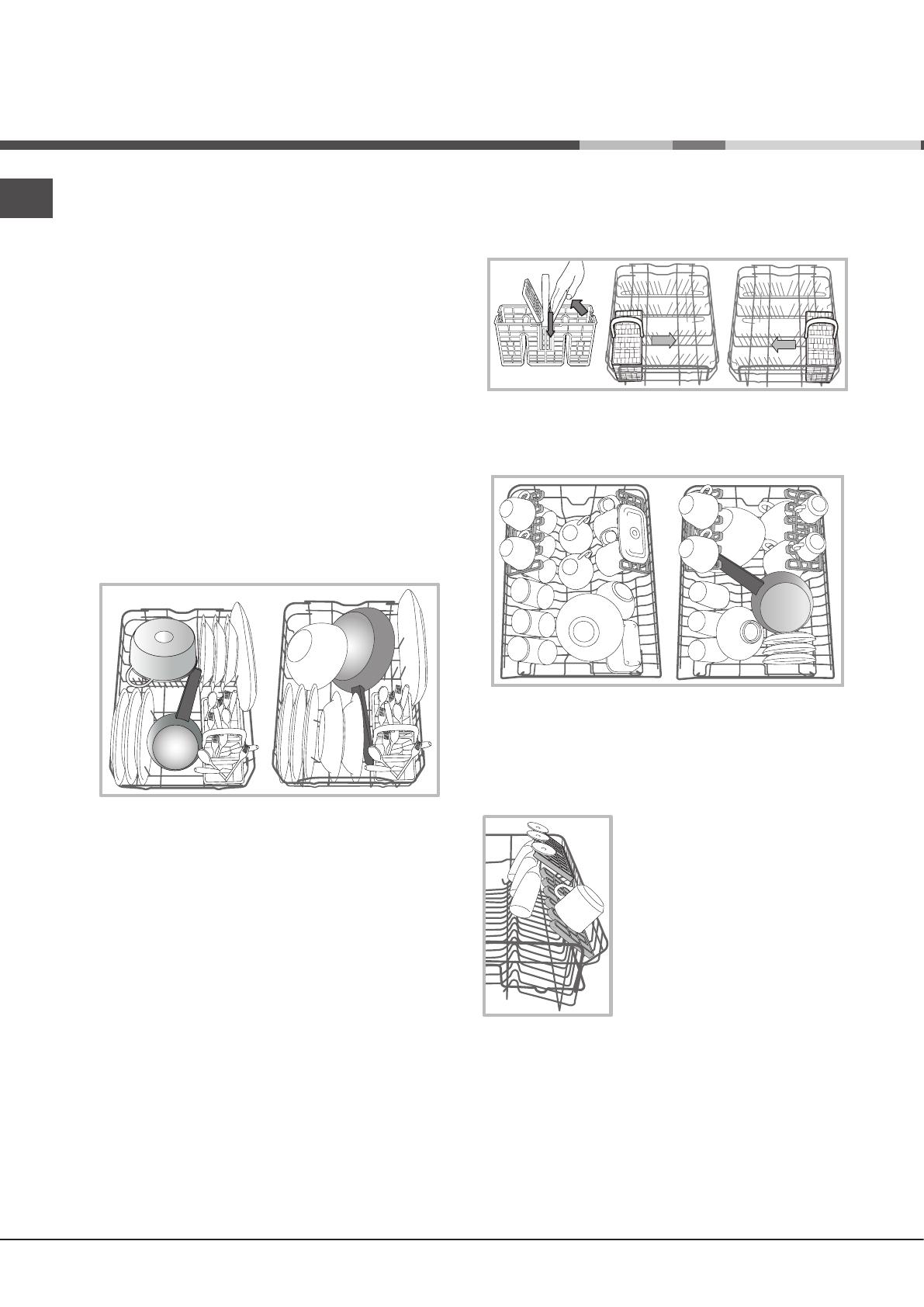
22
EN
Loading the racks
Cutlery basket
The basket is equipped with top grilles for improved cutlery ar-
rangement. The cutlery basket should be positioned only at the
front of the lower rack.
Upper rack
Load this rack with delicate and lightweight crockery such as
glasses, cups, saucers and shallow salad bowls.
Tips
Before loading the racks, remove all food residues from the
crockery and empty liquids from glasses and containers. No
preventive rinsing is needed under running water.
Arrange the crockery so that it is held in place firmly and does
not tip over; and arrange the containers with the openings facing
downwards and the concave/convex parts placed obliquely,
thus allowing the water to reach every surface and flow freely.
Make sure that the lids, handles, trays and frying pans do not
prevent the spray arms from rotating. Place any small items in
the cutlery basket.
Sinceplasticdishesandnon-stickfryingpansusuallyretainmore
water drops, their drying will be not so good as that of ceramic
or stainless-steel dishes.
Lightweight items such as plastic containers should be placed in
the upper rack and arranged so that they cannot move.
After loading the appliance, make sure that the spray arms can
rotate freely.
Lower rack
The lower rack can hold pans, lids, dishes, salad bowls, cutlery
etc. Large plates and lids should ideally be placed at the sides.
Very soiled dishes and pans should be placed in the lower rack
because in this sector the water sprays are stronger and allow
a higher washing performance.
Adjustable position tip-up compartments
The side tip-up compartments can be positioned at three different
heightstooptimizethearrangementofthecrockeryinsidethe
rack.
Wine glasses can be placed safely in
the tip-up compartments by inserting
the stem of each glass into the
corresponding slot.
For optimum drying results incline
the tip-up compartments more. To
change the inclination, pull up the tip-
up compartment, slide it slightly and
position it as you wish.
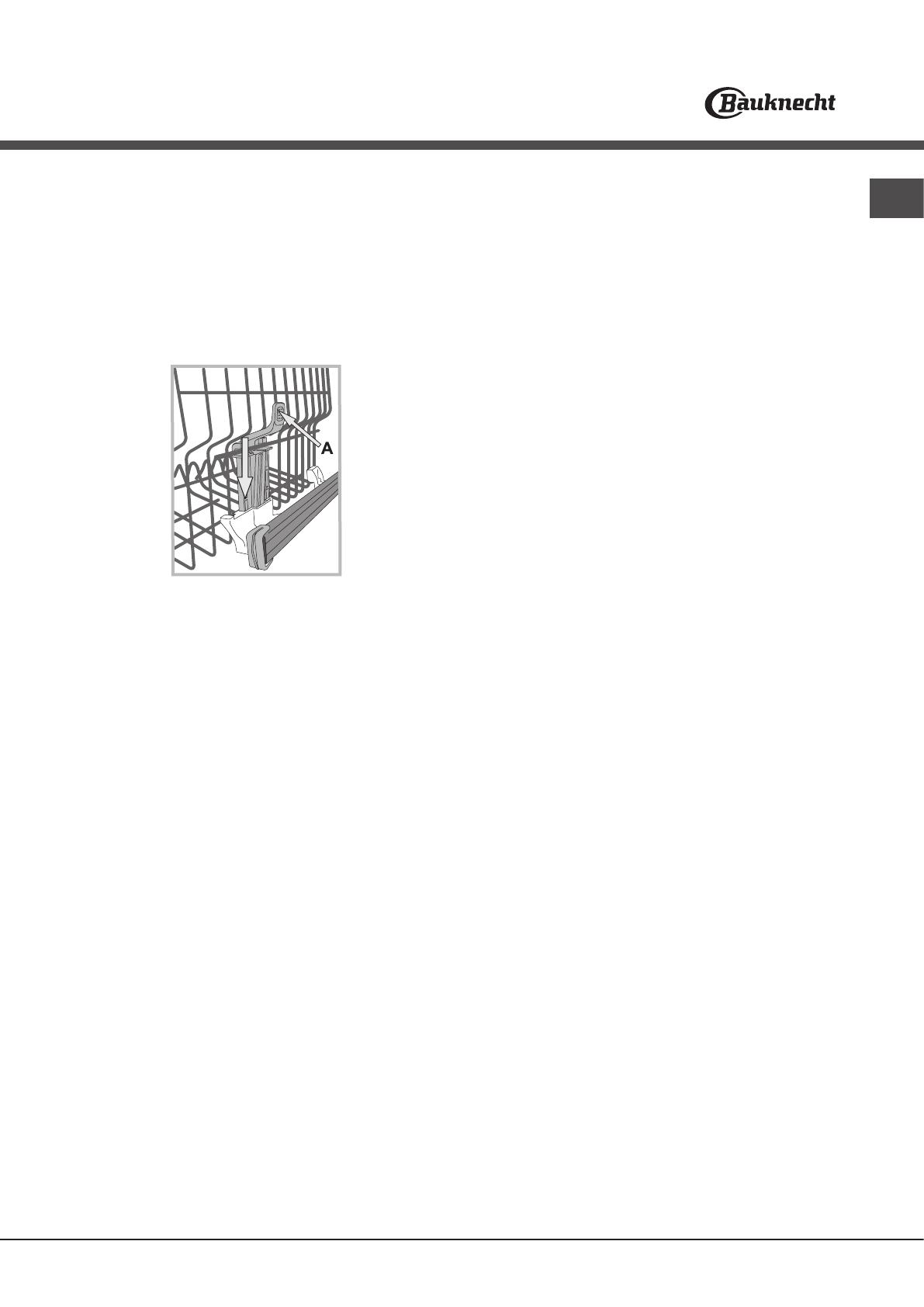
23
EN
Adjusting the height of the upper rack
The height of the upper rack can be adjusted: high position
to place bulky crockery in the lower rack and low position to
make the most of the tip-up compartments by creating more
space upwards.
It is strongly recommended to never adjust height position
when the rack is loaded.
NEVER raise or lower the rack on one side only.
If the rack is equipped with a Lift-Up device
(seefigure)
, lift it
up by holding its sides. To restore the lower position, press the
levers(A) at the sides of the rack and follow the rack down.
Unsuitable crockery
• Woodencrockeryandcutlery.
• Delicatedecoratedglasses,artistichandicraftandantique
crockery. Their decorations are not resistant.
• Partsinsynthetic material which do not withstand high
temperatures.
• Copperandtincrockery.
• Crockerysoiledwithash,wax,lubricatinggreaseorink.
Thecoloursof glass decorations and aluminium/silverpieces
canchangeandfadeduringthewashingprocess.Sometypes
ofglass(e.g.crystalobjects)canbecomeopaqueafteranumber
of wash cycles too.
Damage to glass and crockery
Caused by:
• Typeofglassandglassproductionprocess.
• Chemicalcompositionofdetergent.
• Watertemperatureofrinsecycle.
Tips:
• Onlyuseglasses and porcelain guaranteed by the
manufacturer as dishwasher safe.
• Useadelicatedetergentsuitableforcrockery.
• Collectglassesandcutleryfromthedishwasherassoonas
the wash cycle is over.

24
EN
Detergent and
dishwasher use
Measuring out the detergent
Good washing results also depend on the correct amount of
detergent being used. Exceeding the stated amount does not
result in a more effective wash and increases environmental
pollution.
The amount can be adjusted to the soil level.
In the case of normally soiled items, use approximately either
25g (powder detergent) or 25ml (liquid detergent). If tablets
are used, one tablet will be enough.
If the crockery is only lightly soiled or if it has been rinsed
with water before being placed in the dishwasher, reduce the
amount of detergent used accordingly.
For good washing results also follow the instructions shown
on the detergent box.
For further questions please ask the detergent producers.
Open the detergent dispenser using button D and measure out
the detergent according to the Table of wash cycles:
•powder or liquid: compartments A (wash detergent) and B
(pre-washdetergent)
•tablets:whenthecyclerequires
1 tablet, place it in compartment A
and close cover C; when it requires
2 tablets, place the second tablet
on the bottom of the appliance.
Removedetergent residues from
the edges of the compartment and
close cover C until it clicks.
The detergent dispenser
automatically opens up at the right time according to the wash
cycle.
Ifall-in-onedetergentsareused,werecommendusingtheTABS
option, because it adjusts the cycle so that the best washing and
drying results are always achieved.
Only use detergent which has been specifically designed
for dishwashers.
DO NOT USE washing up liquid.
Using excessive detergent may result in foam residues
remaining in the machine after the cycle has ended.
To achieve the best washing and drying results, the combined
use of detergent, rinse aid liquid and refined salt is required.
We recommend using detergents that do not contain
phosphates or chlorine, as these products are harmful
to the environment.
Starting the dishwasher
1.PressON-OFFbutton.
2. Open the door and measure out the detergent.
(seedetergent
information).
3.Loadtheracks
(seeLoadingtheracks)
and shut the door.
4.Selectthewashcycleinaccordancewiththetypeofcrockery
and its soil level
(seetableofwashcycles)
by pressing the P
button.
5.Selectthewashoptions
(seeSpecialwashcyclesandoptions)
.
6.StartthewashcyclebypressingtheSTART/PAUSEbutton.
7. The end of the wash cycle is indicated by beeps and the
display shows END. Switchofftheappliancebypressingthe
ON/OFFbutton.
8.Waitforafewminutesbeforeremovingthecrockery,inorder
to avoid burns. Unload the racks, beginning with the lower level.
The machine will switch off automatically during certain
extended periods of inactivity, in order to minimise electricity
consumption.
If the crockery is only lightly soiled or if it has been rinsed
with water before being placed in the dishwasher, reduce the
amount of detergent used accordingly.
Modifying a wash cycle in progress
If a mistake was made during the wash cycle selection process,
it is possible to change the cycle, provided that it has only just
begun: in order to change the wash cycle switch off the machine
bypressingandholdingtheON/OFFbutton.Switchthemachine
backonusingtheON/OFFbuttonandselectthenewwashcycle
andanyoptionsdesired;startthecyclebypressingtheSTART/
PAUSEbutton.
Adding extra crockery
Without switching off the machine, open the door, taking care
to avoid the escaping steam, and place the crockery inside the
dishwasher.ShutthedoorandpresstheSTART/PAUSEbutton
the cycle will begin from the point at which it was interrupted.
Accidental interruptions
If the door is opened during the wash cycle, or if there is a power
cut, the cycle stops. once the door has been shut or the electricity
supply is restored, to start again the cycle from where it was
interrupted,presstheSTART/PAUSEbutton.
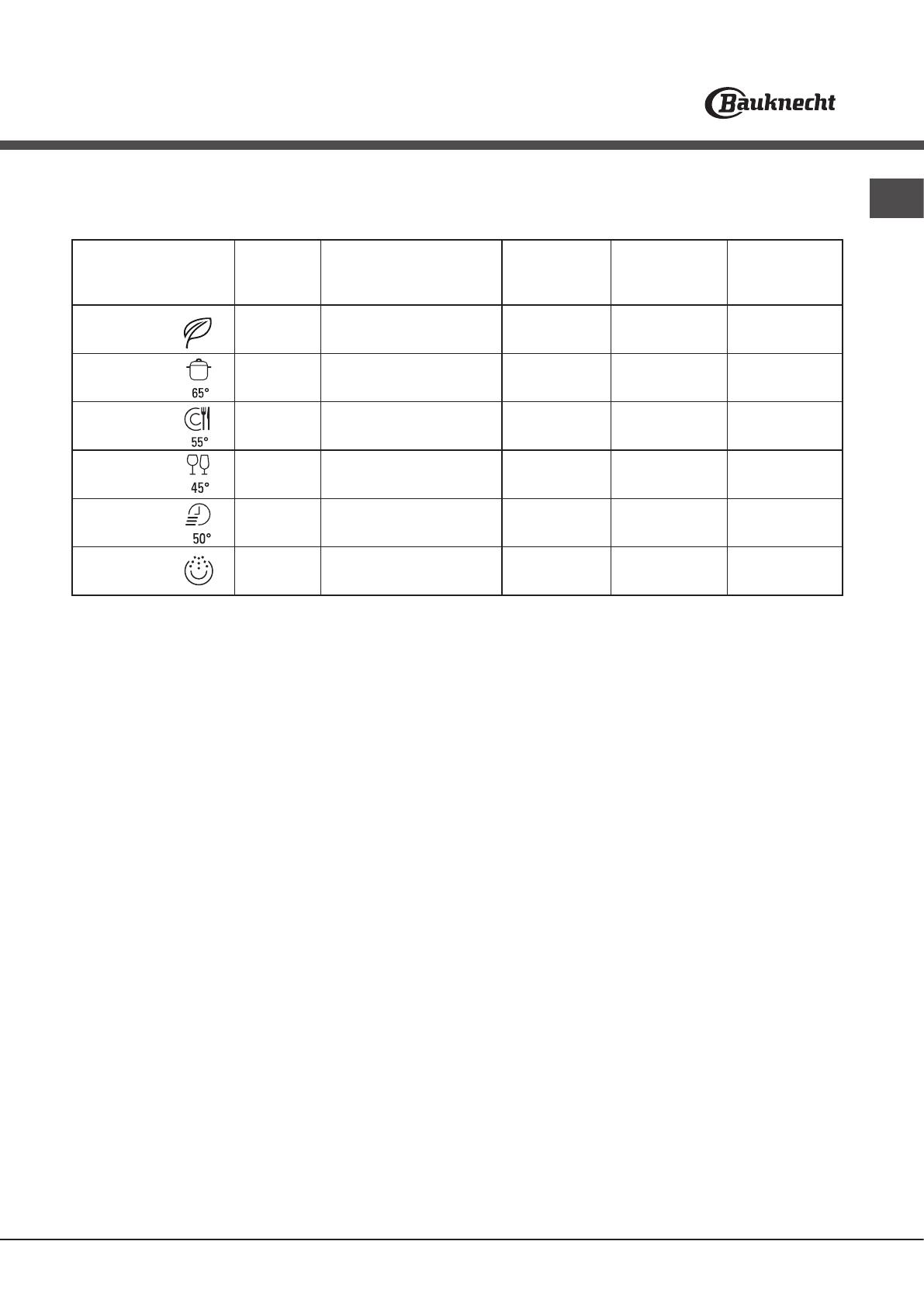
25
Instructions on wash-cycle selection and detergent dosage
1. Normallysoiledcrockery.Standardprogram,themostefficientintermsofitscombinedenergyandwaterconsumption.
4gr/ml**+21gr/ml–1Tab
(**Quantityofpre-washingdetergent)
2. Recommendedprogramforheavilysoiledcrockery,speciallysuitableforpansandsaucepans(nottobeusedfordelicateitems).
25gr/ml–1Tab
3.Normallysoiledpansanddishes.4gr/ml**+21gr/ml–1Tab
4.Cyclefordelicateitems,whicharemoresensitivetohightemperatures,forexampleglassesandcups.25gr/ml–1Tab
5.Fastcycletobeusedforslightlydirtydishes,withnodried-onfood.(idealfor2placesettings)21gr/ml–1Tab
6. Crockery to be washed later.Nodetergent
Standbyconsumption:Left-onmodeconsumption:5W-Offmodeconsumption:0.5W.
Wash cycle
Wash cycle
which
include
drying
Options
Approximate
duration of
wash cycles
h:min.
Water
consumption
(l/cycle)
Energy
consumption
(kWh/cycle)
1. Eco Yes
Start Delay - Half Load - Tab -
Hygiene Rinse
03:00 10 0,83
2. Intensive Yes Start Delay - Half Load - Tab 02:30 14 1,3
3. Normal Yes Start Delay - Half Load - Tab 02:00 13,5 1,15
4. Fragile Yes Start Delay - Half Load - Tab 01:40 10 0,95
5. Rapid No Start Delay - Tab 00:25 8,5 0,5
6. Prewash No Start Delay – Half Load 00:10 4,0 0,01
EN
Wash-cycledataismeasuredunderlaboratoryconditionsaccordingtoEuropeanStandardEN50242.
Based on the different conditions of use, the wash-cycle duration and data can change.
Wash cycles
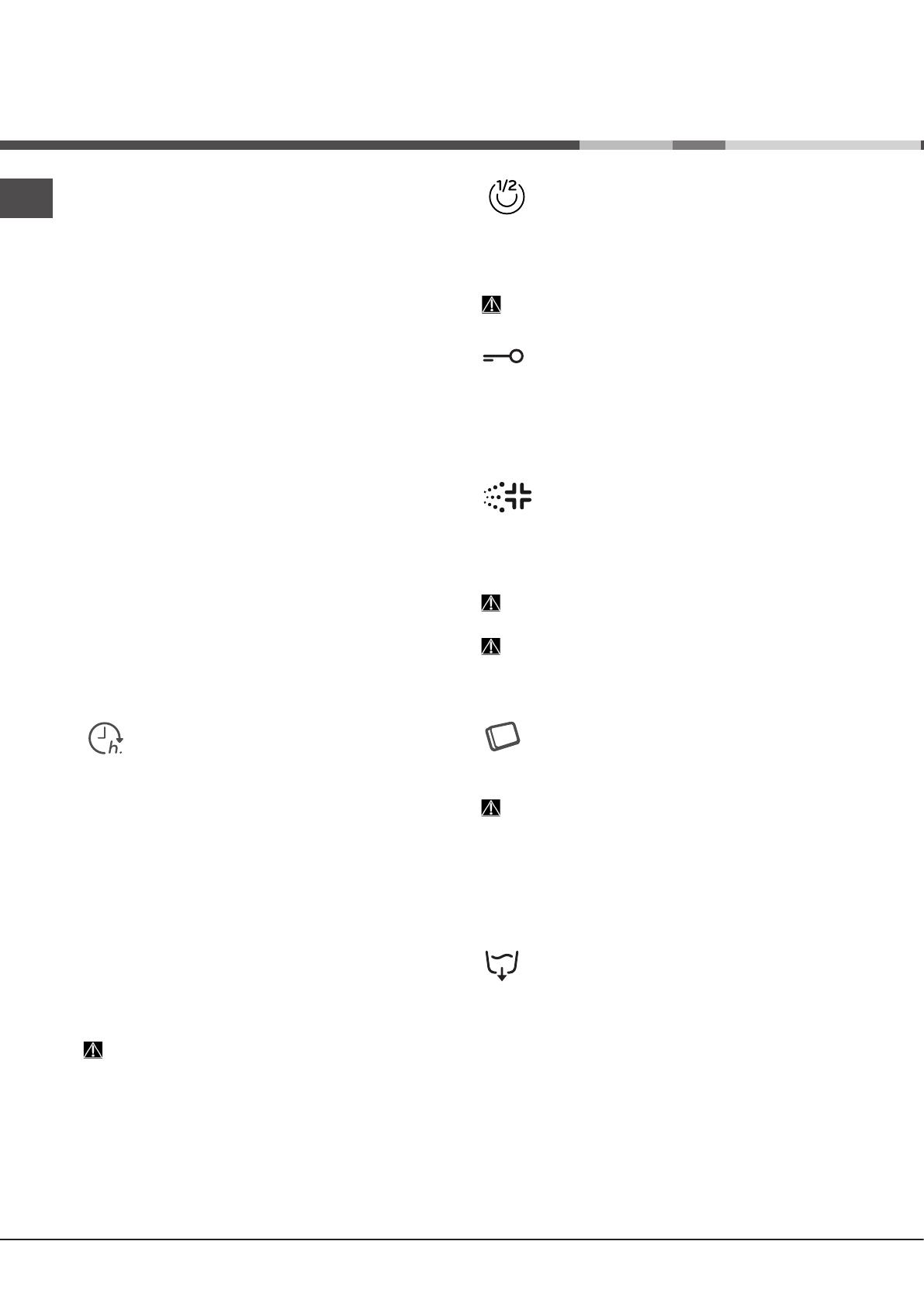
26
EN
Special wash cycles
and Options
Notes:
Optimum performance levels when using the “1 Hour” and
“Rapid” cycles can be achieved by respecting the specified
number of place settings.
To reduce consumption even further, only run the dishwasher
when it is full.
Note for Test Laboratories: forinformationoncomparativeEN
testing conditions, please send an email to the following address:
Drain out
To stop and cancel the active cycle, the Drain Out
function can be used.
AlongpressofSTART/PAUSEbutton,willactivatetheDRAIN
OUT function. The active cycle will be stopped and the water in
the dishwasher will be drained out.
Tablet option (Tab)
AlongpressofHygieneRinsebutton,willactivatethe
TABLET function. This option optimises washing and drying
results. To deactivate the TABLET, long press again.
The “Tablet” option results in a longer wash cycle.
Hygiene Rinse Option
This option allows higher temperatures to be used.
Selectthewashingprogram,presstheHygieneRinsebuttonand
the indicator light will switch on. To deselect the option, press
the same button again.
Ideal to clean crockery and feeding bottles.
Warning:thecrockeryandplatescouldbeextremelyhotat
the end of the cycle.
TheHygieneRinseoptionresultsinlengtheningofthewash
cycle.
Half Load option
If there are not many dishes to be washed, a half
load cycle may be used in order to save water, electricity and
detergent.Select the wash cycle and press the HALF LOAD
button: the indicator light will illuminate.
PresstheHALFLOADbuttontodeselectthisoption.
Remember to halve the amount of detergent.
Child safety lock
A long press of HALF LOAD button, will activate the
SAFETYLOCKfunction.TheSAFETYLOCKfunctionwillblockthe
controlpanel.TodeactivatetheSAFETYLOCK,longpressagain.
Wash options
The OPTIONS may only be set, changed or reset after the
wash cycle has been selected and before the Start/Pause
button has been pressed.
Only the options which are compatible with the type of wash
cycle set may be selected. If an option is not compatible
with the selected wash cycle
(seeTableofwashcycles)
, the
correspondingled/symbolflashesrapidly3times.
If an option is selected which is not compatible with another
(previouslyselected)option,itwillflash3timesandswitch
off, while the most recently selected option will remain active.
To deselect an option which has been set by mistake, press
the corresponding button again.
Delayed start
The start of the program may be delayed for
a period of time between 0:30 and 24 hours.
1.Selecttheprogram and anydesiredoptions. Press the
DELAYED START button (repeatedly) to delay the start of
theprogram.Adjustablefrom0:30to24hours.
With each press of the button, the delay start increases by:
0:30 if selection below 4 hours, 1:00 if selection is below
12hours,4hoursifselectionisabove12hours.If24hours
reached, and the button is pressed, the delayed start is
deactivated.
2. Press the START/PAUSE button: the timer will begin
counting down;
3.Oncethistimehaselapsed,theindicatorlightswitches
off and the program begins automatically. If at the time of
thecountdowntheSTART/PAUSEbuttonispressedagain
the DELAYEDSTART option is cancelled and the selected
program starts automatically.
The Start Delay function cannot be set once a wash cycle
has started.

27
EN
Care and maintenance
Shutting off the water and electricity supplies
• Turnoffthewatertapaftereverywashcycletoavoidleaks.
• Always unplug the appliance when cleaning it and when
performing maintenance work.
Cleaning the dishwasher
• Theexternalsurfacesofthemachineandthecontrolpanel
can be cleaned using a non-abrasive cloth which has been
dampened with water. Do not use solvents or abrasive
products.
• Anymarksontheinsideoftheappliancemayberemoved
using a cloth dampened with water and a little vinegar.
Preventing unpleasant odours
• Alwayskeepthedooroftheapplianceajarinordertoavoid
moisture from forming and being trapped inside the machine.
• Cleanthesealsaroundthedooranddetergentdispensers
regularly using a damp sponge. This will avoid food becoming
trapped in the seals, which is the main cause behind the
formation of unpleasant odours.
Cleaning the spray arms
Food residue may become encrusted onto the spray arms
and block the holes used to spray the water. It is therefore
recommended that you check the arms from time to time and
clean them with a small non-metallic brush.
The two spray arms may both be removed.
To remove the upper spray arm,
turn the plastic locking ring in an
anti-clockwise direction. The upper
spray arm should be replaced
so that the side with the greater
number of holes is facing upwards.
The lower spray arm can be
removed by pressing on the side
tabs and pulling it upwards.
Cleaning the water inlet hose
Ifthewaterhosesareneworhavenotbeenusedforanextended
period of time, let the water run to make sure it is clear and free
of impurities before performing the necessary connections. If this
precaution is not taken, the water inlet could become blocked
and damage the dishwasher.
Clean the water inlet filter at the tap outlet regularly.
- Turn off the water tap.
- Unscrew the end of the water inlet hose, remove the filter and
clean it carefully under running water.
-Re-placethefilterandscrewthewaterhosebackintoposition.
Cleaning the filters
The filter assembly consists of three filters which remove food
residues from the washing water and then recirculate the water.
They must be cleaned if you wish to achieve the best results in
every wash.
Clean the filters regularly.
The dishwasher must not be used without filters or if the filter
is loose.
•Afterseveralwashes,checkthefilterassemblyandifnecessary
clean it thoroughly under running water, using a non-metallic
brush and following the instructions below:
1. Turn the cylindrical filter C in an anti-clockwise direction and
pull it out
(fig.1).
2.RemovethecupfilterBbyexertingaslightpressureonthe
side flaps
(fig.2);
3.Slideoutthestainless-steelplatefilterA.
(fig.3).
4. Inspect the trap and remove any food residues. NEVER
REMOVE the wash-cycle pump protection
(blackdetail)(fig.4).
Aftercleaningthefilters,re-placethefilterassemblyandfixit
in position correctly; this is essential for maintaining the efficient
operation of the dishwasher.
Leaving the machine unused for extended
periods
• Disconnecttheappliancefromtheelectricitysupplyandshut
off the water tap.
• Leavethedooroftheapplianceajar.
• Whenyoureturn,runawashcyclewhenthedishwasheris
empty.

28
195139922.00 - NC
11/2015jk-XeroxFabriano
EN
Troubleshooting
Whenever the appliance fails to work, check for a solution from the following list before calling for Assistance.
Problem: Possible causes / Solutions:
The dishwasher does not start
or cannot be controlled.
• The water supply tap is not turned on.
• Switch off the appliance by pressing the ON/OFF button, switch it back on after approximately
one minute and reset the wash cycle.
• The appliance has not been plugged in properly or another electricity socket should be used.
• The dishwasher door has not been closed properly.
The door won’t close.
• Make sure that the racks were inserted all the way.
• The lock was released. Strongly push the door until a “clacking” noise is heard.
No water drain out of the
dishwasher.
• The wash cycle has not nished yet.
• The water drain hose is bent
(see Installation).
• The drain duct is clogged up.
• The lter is clogged up with food residues.
• Check the height of the drain hose.
The dishwasher makes
excessive noise.
• The dishes are rattling against each other or against the spray arms. Place the dishes
properly and make sure the spray arms can rotate freely.
• Too much foam: the detergent has not been measured out correctly or it is not suitable for use
in dishwashers.
(See Detergent and dishwasher use.)
Do not prewash the dishes by hand.
The dishes and glasses are
covered in a white lm or
limescale deposits.
• No rened salt.
• Water hardness adjustment is not suitable: increase the relevant values.
(See Rened Salt
and Rinse Aid.)
• The salt and rinse-aid dispenser cap has not been closed properly.
• The rinse aid has been used up or the dosage is too low.
The dishes and glasses are
streaked or have a bluish
tinge.
• The rinse aid dosage is too high.
The crockery has not been
dried properly.
• A wash cycle without a drying programme has been selected.
• The rinse aid has been used up.
(See Rened Salt and Rinse Aid.)
• The rinse aid dispenser setting is not suitable.
• The crockery is made from non-stick material or plastic; the presence of water drops is
normal.
The dishes are not clean. • The crockery has not been arranged properly.
• The spray arms cannot rotate freely, being hindered by the dishes.
• The wash cycle is too gentle
(see Wash Cycles).
• Too much foam: the detergent has not been measured out correctly or it is not suitable for use
in dishwashers.
(See Detergent and dishwasher use.)
• The lid on the rinse aid compartment has not been closed correctly.
• The lter is dirty or clogged up
(see Care and maintenance.)
• The rened salt level is low
(See Rened Salt and Rinse Aid.)
• Make sure that the height of the dishes is compatible with the rack adjustment.
• The holes in the spray arms are clogged up.
(See Care and maintenance.)
The dishwasher won’t load
any water.
It is blocked with ashing lights.
• There is no water in the mains supply or the tap is shut off.
• The water inlet hose is bent
(see Installation).
• The lters are clogged up: they need cleaning.
(See Care and maintenance.)
• The drain duct is clogged up: it needs cleaning.
• After checking and cleaning, switch the dishwasher on and off and start a new wash cycle.
• If the problem persists, turn off the water tap, remove the plug and call the Service Centre.
/
